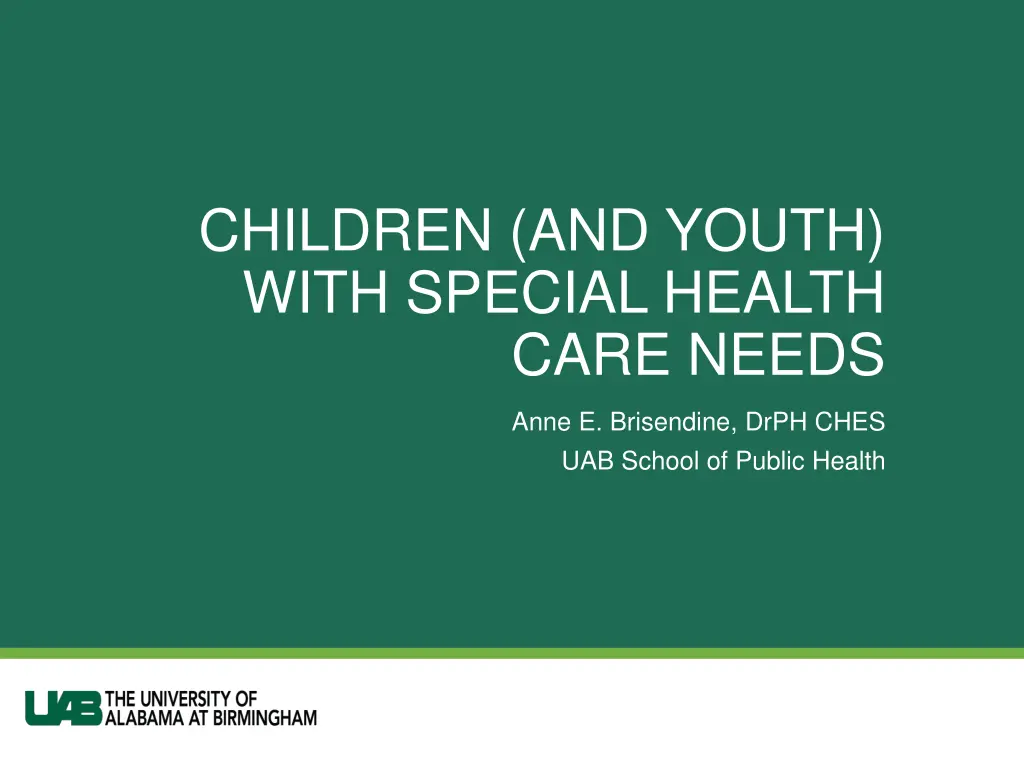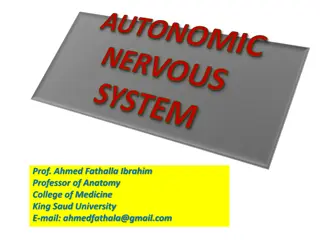
Understanding Children with Special Health Care Needs
Learn about the importance of People-First Language, outdated terms to avoid, and various definitions related to children with special health care needs. Explore statistics from the National Survey of Children's Health and gain insights into the challenges and services required by Children with Special Health Care Needs.
Download Presentation

Please find below an Image/Link to download the presentation.
The content on the website is provided AS IS for your information and personal use only. It may not be sold, licensed, or shared on other websites without obtaining consent from the author. If you encounter any issues during the download, it is possible that the publisher has removed the file from their server.
You are allowed to download the files provided on this website for personal or commercial use, subject to the condition that they are used lawfully. All files are the property of their respective owners.
The content on the website is provided AS IS for your information and personal use only. It may not be sold, licensed, or shared on other websites without obtaining consent from the author.
E N D
Presentation Transcript
CHILDREN (AND YOUTH) WITH SPECIAL HEALTH CARE NEEDS Anne E. Brisendine, DrPH CHES UAB School of Public Health
THANKS TO: JULIE PRESKITT, MSOT MPH PHD & SUSAN COLBURN FOR SHARING THEIR SLIDES
PEOPLE FIRST LANGUAGE AND AVOIDING DISPARAGING TERMS Putting the person first Using language that is affirming and respectful of the individual child with a disability or child with special needs NOT disabled child or special needs kid or handicapped child child with autism NOT autistic child uses a wheelchair not wheelchair-bound has an intellectual disability NOT retarded
People First Language Outdated language: People First Language: He has a disability. He is handicapped. She has autism. She s autistic. He uses a wheelchair. He is wheelchair bound. She has a learning disability. -or- She has dyscalculia. She s LD. She has Down Syndrome. She s Downs. She received a traumatic brain injury. She s brain damaged. He s special ed. He receives special education services.
MANY TERMS, MANY DEFINITIONS Special Needs Developmental Delay Chronic Conditions Developmental Disabilities Children with Special Health Care Needs Disability
CHILDREN WITH SPECIAL HEALTH CARE NEEDS (CSHCN) Children who have or are at increased risk for chronic physical, developmental, behavioral, or emotional conditions, and who require health and related services of a type or amount beyond that required by children generally. (McPherson et. al, 1998)
NATIONAL SURVEY OF CHILDREN S HEALTH (2016/17) About 21.3% of children in Alabama have special health care needs compared with nearly 19.4% for the nation. This translates to 235,517 Alabama children or www.cshcndata.org
or Almost 32 sell-out crowds in the ASU Dunn-Oliver Acadome 7,400
or almost 8 sell-out crowds at the new Hornets Stadium 26,000
POTENTIAL IMPACTS FOR CHILDREN Broad implications for developing child Physical development/growth Cognitive development/intellectual skills Social/emotional skills Behavior Communication/language development Self care skills and independence
POTENTIAL IMPACTS (CONT.) Missed school days (illness, appointments) Poor or lower school performance Limited or reduced participation in activities Social isolation; problems with social interaction; self-esteem issues Medication side effects Family stress and financial burden
SUPPORTING PROGRAMS Early intervention: provides array of services for children 0-3 with developmental delay according to an Individualized Family Service Plan (IFSP); services occur in the child s natural environment Preschool programs: specialized education and related services for children 3-5 with disabilities and delays Early Head Start/Head Start: programs for children 0-5 from families with incomes below poverty; 10% must have a disability
SUPPORTING PROGRAMS (CONT.) Title V CSHCN programs: state programs funded (all or partly) by MCH Block Grant (Children s Rehabilitation Service here in Alabama) Special education: education and related services for children 3-21 who qualify under specific category; provided according to an Individualized Education Plan (IEP) Hospital clinics and private physicians, therapists, etc.
FAMILY-CENTERED CARE Family Professional Partnerships
FAMILY-CENTERED CARE Foundation of family-centered care is the partnership between families and professionals
Family-Centered Care assures the health and well- being of children and their families through a respectful family-professional partnership. It honors the strengths, cultures, traditions and expertise that everyone brings to this relationship. Family- Centered Care is the standard of practice which results in high quality services. National Center for Family and Professional Partnerships
FAMILY-CENTERED CARE IS A MODEL OF CARE THAT: values the culture, strengths, and knowledge of the family. works to prevent poor outcomes among providers. makes sure the focus is family-centered. provides care coordination that values concerns of families. considers the family as an indispensable part of the team. at its heart, honors the family s story.
PATIENT- AND FAMILY- CENTERED CARE An approach to the planning, delivery, and evaluation of health care that is grounded in mutually beneficial partnerships among health care providers, patients and families. Institute for Patient- and Family-Centered Care
KEYS TO SUCCESSFUL PARTNERSHIP Families and professionals work together in the best interest of the child and the family. As the child grows, s/he assumes a partnership role. There is mutual respect for the skills and expertise each partner brings to the relationship. Trust is fundamental. Communication and information sharing are open and objective. Participants make decisions together. There is a willingness to negotiate.
10 COMPONENTS OF FAMILY-CENTERED CARE 1. Acknowledges the family as the constant in a child s life. 2. Builds on family strengths. 3. Supports the child in learning about and participating in his/her care and decision-making. 4. Honors cultural diversity and family traditions. 5. Recognizes the importance of community-based services. 6. Promotes an individual and developmental approach. 7. Encourages family-to-family and peer support. 8. Supports youth as they transition to adulthood. 9. Develops policies, practices, and systems that are family-friendly and family-centered in all settings. 10. Celebrates successes (National Center for Family-Centered Care (1989); Bishop, Woll and Arango (1993))
WHAT DO YOU THINK OF WHEN YOU THINK OF A FAMILY? https://encrypted-tbn1.gstatic.com/images?q=tbn:ANd9GcQ6sAIPMLHDqduC3pTED7EGKVBhMOABBZRD2GSN_f7pdyGOjwIwOw https://encrypted-tbn0.gstatic.com/images?q=tbn:ANd9GcRbPgeonXguLRzYwEQaDuy2madA6rPmGnAETu60ZySWjkw1P80O6g https://encrypted-tbn3.gstatic.com/images?q=tbn:ANd9GcTUrWY3L7DqtdR4PSVJ3BsBg1YqxLWoBEx5sQxtafu9-Kt_cO_JSw https://encrypted-tbn3.gstatic.com/images?q=tbn:ANd9GcRQGzkEqPoZrjM2E2nh9h_BRCbLvmvQpECQs48jTAtuuwBUoXQwDA
WHAT DO WE MEAN BY FAMILY? Families are big, small, extended, nuclear, multi-generational, with one parent, two parents, and grandparents. We live under one roof or many. A family can be as temporary as a few weeks or as permanent as forever. We become part of a family by birth, adoption, marriage, or from a desire for mutual support. A family is a culture unto itself, with different values and a unique way of realizing its dreams. Together, our families become the source of our rich cultural heritage and spiritual diversity. Our families create neighborhoods, communities, states and nations. -Task Force on Young Children and Families, New Mexico State Legislature
WHAT DO WE MEAN BY FAMILY? Jane Temple Howardwrote in her book Families in 1978 Call it a clan, call it a network, call it a tribe, call it a family. Whatever you call it, whoever you are, you need one.
WHAT DO WE MEAN BY FAMILY? Family refers to two or more people who are related in any way - biologically, legally or emotionally. Our patients define who their family is to them. - The Christ Hospital in Cincinnati, Ohio
RECOGNIZING THE DRIVING FORCES oSystem-Centered Driving Force: The priorities of the system and those who work within it drive the delivery of health care. oPatient-Focused Driving Force: The patient is the focus or unit of care. Interventions are done to and for him/her, instead of with the patient. The patient is not viewed within the context of family or community. o Family-Focused Driving Force: While the family is the focus or the unit of care, interventions are done to and for them, instead of with them. o Patient-and Family-Centered Driving Force: The priorities and choices of patients and their families drive the delivery of health care. Dr. Bill Schwab, MD, University of Wisconsin: Partners in Care Summit, 2016
Patient- and family- centered care is working with patients and families, rather than doing to or for them.
FAMILY/PROFESSIONAL PARTNERSHIPS At all levels of Health Care In the care for an individual patient In program planning and evaluation At the policy level
FAMILY/PROFESSIONAL PARTNERSHIPS POLICIES AND PRACTICES o Patients and families are seen as essential members of the health care team o In the hospital or clinic, families are no longer viewed as visitors o All staff and clinicians introduce themselves in all encounters o Patients and families are supported in self- management
COLLABORATION- Collaboration means that no one interest group is always right. It means taking what you think, and what I think, and what someone else thinks, and coming up with something that works for everyone. Bev McConnell Crider, Family Leader From: Essential Allies: Families as Advisors
ELEMENTS OF COLLABORATION/PARTNERSHIP: Mutual respect Honest and clear communication Understanding and empathy Mutually agreed upon goals Open and two-way sharing of information Accessibility and responsiveness Joint evaluation of progress Absence of labeling and blaming Dr. Bill Schwab, MD, University of Wisconsin: Partners in Care Summit, 2016
CHALLENGES/BARRIERS TO COLLABORATION/PARTNERSHIP: Attitudes/perceptions Past experiences Cultural differences Socioeconomic and educational influences Lack of skills Lack of logistical and administrative support Different purposes and agendas Dr. Bill Schwab, MD, University of Wisconsin: Partners in Care Summit, 2016
FAMILY/PROFESSIONAL PARTNERSHIPS: RULES TO LIVE BY oAttitude is everything oValues determine outcomes oAll families have strengths oSensitivity does not mean psychoanalysis oCase management is not the answer oPatients and families are the experts on the experience of being service consumers Dr. Bill Schwab, MD, University of Wisconsin: Partners in Care Summit, 2016
o Assist in problem solving o Make a choice to teach; Make a choice to learn; o Honor and encourage natural supports oDon t be afraid to say I don t know o Develop roles for patient and family consultants o Create alliances with other professionals at a personal level o Make relationships work o Develop financial creativity o Make time to talk Dr. Bill Schwab, MD, University of Wisconsin: Partners in Care Summit, 2016
FAMILY/PROFESSIONAL PARTNERSHIPS: TRICKS OF THE TRADE oTreat each person as an individual oRespect patient and family knowledge about their own health needs oMeet patients and families where they are oNegotiate your role and responsibility oShare knowledge and information oAvoid labeling Dr. Bill Schwab, MD, University of Wisconsin: Partners in Care Summit, 2016






















